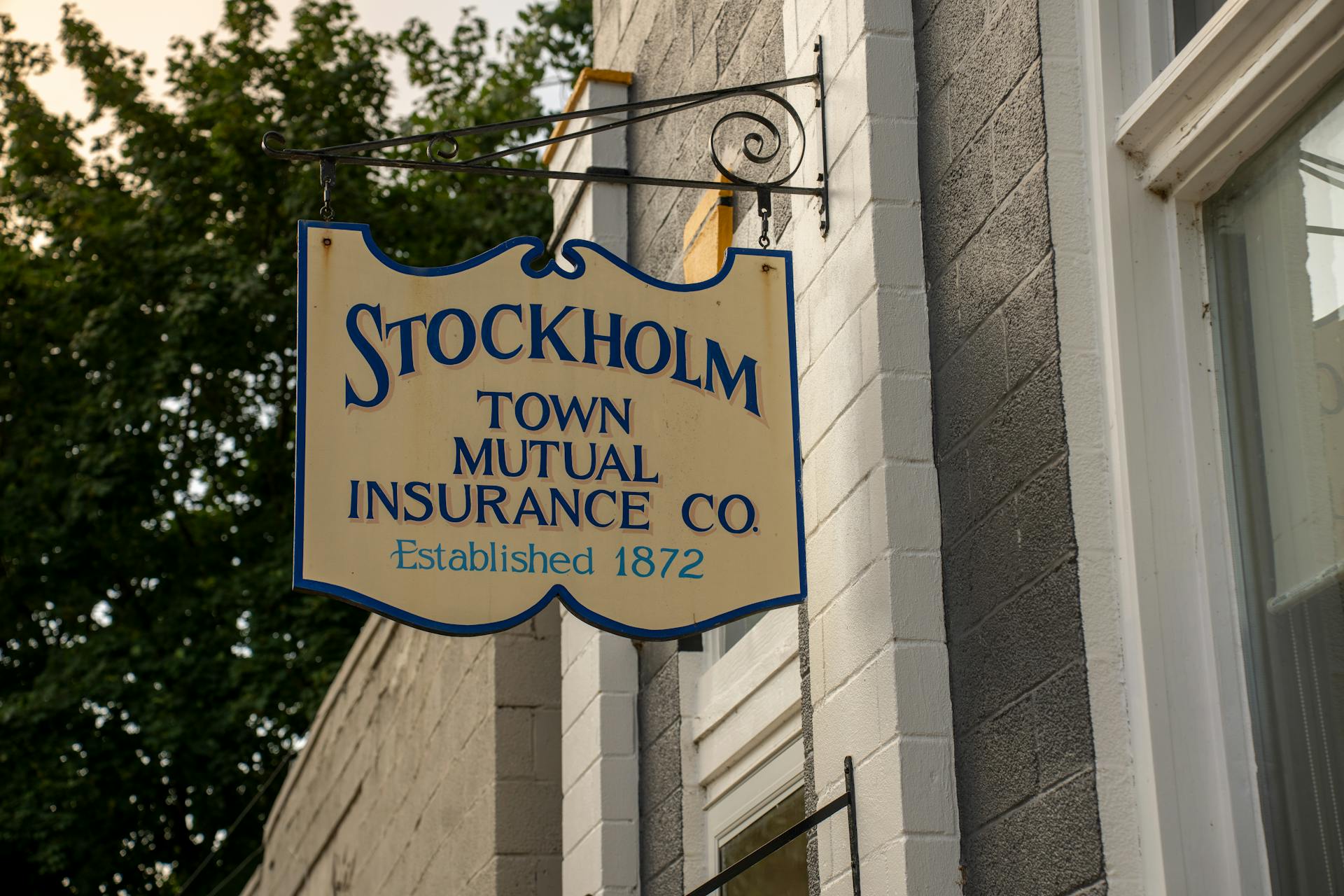
Having the right insurance in place is crucial for social service organizations to protect themselves from unforeseen risks and ensure they can continue to provide vital services to their communities.
Liability insurance, for instance, can help cover costs associated with lawsuits and settlements, which is a major concern for organizations that work with vulnerable populations.
The average cost of a liability claim can range from $100,000 to $1 million or more, depending on the circumstances.
This is why many social service organizations opt for insurance policies that include liability coverage, which can provide peace of mind and financial protection.
Insurance for social service organizations can also provide protection for physical assets, such as buildings and equipment, in the event of damage or loss.
Three Categories
As a social service organization, it's essential to understand the different types of insurance that can protect your nonprofit from various risks. Here are the three main categories of commercial insurance policies that nonprofits typically fall under:
Property coverage finances the cost to repair or replace property your nonprofit owns, or property in your care, custody and control.
Liability coverage responds to legal claims and demands alleging wrongdoing on the part of your nonprofit, with two components: indemnity coverage to make the victim of harm or loss "whole", and defense coverage to cover the cost of counsel to represent and defend your nonprofit.
Life/Health (Benefits) Coverage offers a range of benefits to employees, including health insurance, life insurance, and short-term and long-term disability coverage.
Here's a breakdown of the three categories:
- Property Coverage: covers damage or loss to property owned or in care, custody and control
- Liability Coverage: has two components: indemnity coverage and defense coverage
- Life/Health (Benefits) Coverage: includes health insurance, life insurance, and disability coverage
Property Insurance
Property insurance is a must-have for social service organizations to protect against losses or damage caused by fire, theft, vandalism, or other covered incidents.
It can help your organization recover, resume operations, and replace essential assets without incurring significant financial burdens.
Property insurance can cover a wide range of assets, including buildings, machinery, furniture, equipment, payroll and money, inventory, outdoor property, and extra expenses.
Here are some specific types of property insurance coverage:
In today's litigious environment, it's essential for non-profits and human services organizations to have effective property and casualty insurance to protect against potential threats.
Liability Insurance
Liability Insurance is a crucial aspect of insurance for social service organizations. It protects against allegations of vicarious liability, negligence, and errors and omissions in the professional services provided.
You may be wondering what types of liability coverages are available. There are eight commonly purchased liability policies, including Excess Liability Insurance policies, which provide additional limits and drop-down coverage for underlying policies.
Excess Liability Insurance policies can provide excess limits over policies written with a claims-made trigger, which is different from Umbrella policies. This means a nonprofit organization may have two policies providing additional limits above its primary policies: an Umbrella and an Excess Liability Insurance policy.
Some insurers offer a combined policy with Umbrella coverage and Excess Liability coverage over claim-made primary policies.
Here are some examples of professionals and individuals who may be protected by Social Service Professional Liability (SSP) coverage:
- Acupuncturists
- Adoption service employees
- Aides
- Assisted living providers
- Certified nursing assistants
- Childcare workers
- Chiropractors
- Counselors
- Daycare providers
- Educators
- Home health aides
- Instructors
- LPNs
- Mentors
- Nurse assistants
- Nutritionists
- Opticians
- Phlebotomists
- Psychotherapists
- Psychologists
- Resident home care providers and supervisors
- RNs
- Social workers
- Teachers
- Therapists
- Tutors
- Veterinarians
Workers' Compensation
Workers' compensation insurance is a must-have for social service organizations to fulfill their duty of care toward their employees.
Your employees are the heart of your organization, and protecting them from workplace injuries or illnesses is crucial.
Workers' compensation insurance helps promote a safe work environment and mitigates the financial burdens associated with workplace injuries or illnesses.
Nonprofits and human services organizations can rely on industry-leading workers compensation programs that include loss mitigation strategies.
Industry-leading workers compensation programs for loss mitigation often include in-house case management, telemedicine, and rehabilitation services.
Some insurance companies determine the cost of workers' compensation by representing a range of carriers.
By choosing the right insurance provider, social service organizations can find a workers' compensation program that meets their specific needs and budget.
A fresh viewpoint: Do Schools Have Insurance for Injuries
General Information
Insurance for social service organizations is a crucial aspect of their operations. Many social service organizations rely on government funding, which can be unpredictable and subject to change.
Social service organizations often provide essential services to vulnerable populations, such as children, the elderly, and people with disabilities. These services can include childcare, senior centers, and disability support.
Insurance can help protect these organizations from financial losses due to unforeseen events, such as natural disasters or employee misconduct. For example, a flood could damage a childcare center's facilities, causing significant financial losses.
Social service organizations can also use insurance to manage risk and ensure continuity of services. This can be especially important for organizations that provide critical services to vulnerable populations.
Insurance can help cover the costs of damage to property and equipment, as well as the costs of replacing or repairing damaged items.
For another approach, see: Accidental Damage Buildings Insurance
Protection and Risk
Protection and Risk is a top priority for social service organizations. Having the right insurance in place can help mitigate risks and protect your organization from potential threats.
Holistic protection is key, and comprehensive insurance can help streamline operations by covering all aspects of your organization, from people to property. This includes property insurance, which is available in several forms to suit your organization's specific needs, such as buildings, machinery, and inventory.
On a similar theme: General Insurance Rating Organization of Japan
Liability insurance is also crucial, providing protection from damages caused by bodily injury or property damage. This includes General Liability, Professional Liability, and Abuse & Molestation Coverage, which can help protect your organization from claims of negligence or wrongdoing.
Cyber liability insurance is another essential component, safeguarding your organization from the financial and reputational risks associated with data breaches, cyberattacks, or unauthorized access to sensitive information.
Here are some key types of liability insurance to consider:
- General Liability
- Professional Liability
- Infestation Liability Coverage
- Abuse & Molestation Coverage
- Employment Practices Liability
- Employee Benefits Liability
- Cyber Liability
- Directors & Officers Liability
- Crime – Employee Dishonesty Coverage
- Fiduciary Liability
- Commercial Umbrella
Cyber
Cyber risks are a major concern for organizations today. Cyber liability insurance can help protect your organization from the financial and reputational risks associated with data breaches, cyberattacks, or unauthorized access to sensitive information.
This type of insurance can safeguard the personal information of beneficiaries, donors, and employees, and help maintain trust. It can also mitigate the potential financial and legal consequences of a cyber incident.
We offer a Cyber Risk Management Portal to help you manage and mitigate cyber risks. Our claims professionals are dedicated to working with you to achieve cost-effective solutions in resolving your claims.
Here are some key types of cyber insurance coverages:
- Cyber
- Cyber Risk Management Portal
These coverages can help protect your organization from a wide range of cyber-related risks.
Holistic Protection
Having comprehensive insurance is key to protecting your organization from all angles. Our holistic approach ensures that all aspects of your organization, from people to property, are protected.
Comprehensive insurance can be tailored to suit your organization's specific needs. For example, it can include various forms of property insurance such as buildings, machinery, furniture, and equipment.
Liability insurance is also an essential part of holistic protection. This type of insurance provides protection from damages caused by bodily injury or property damage for which your organization is found to be legally liable.
Here are some key types of liability insurance to consider:
- General Liability
- Professional Liability
- Infestation Liability Coverage
- Abuse & Molestation Coverage
- Employment Practices Liability
- Cyber Liability
- Directors & Officers Liability
- Crime – Employee Dishonesty Coverage
- Fiduciary Liability
- Commercial Umbrella
By having a comprehensive insurance plan in place, you can have peace of mind knowing that your organization is protected from a wide range of potential risks.
Sources
- https://nonprofitrisk.org/resources/contemplating-coverage-insurance-for-nonprofits/
- https://www.churchmutual.com/insurance/nonprofits-human-services-organizations
- https://insurancefornonprofits.org/coverages/social-service-professional-liability/
- https://www.berkley.com/business-insurance/non-profit
- https://bitnerhenry.com/nonprofits-social-services/
Featured Images: pexels.com


